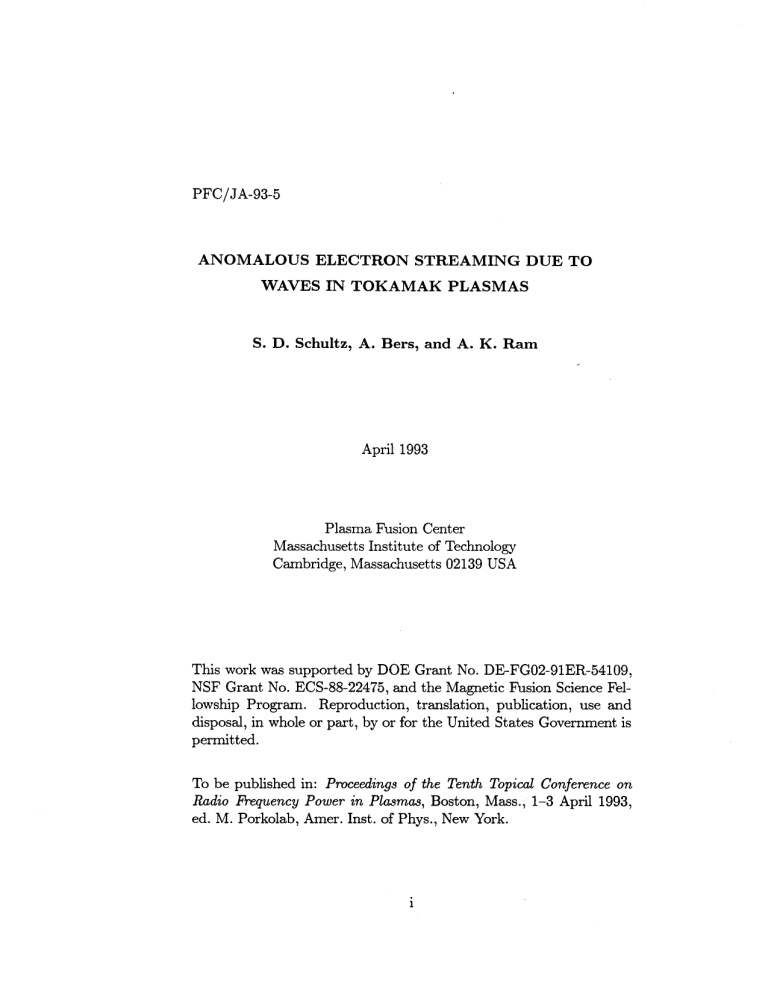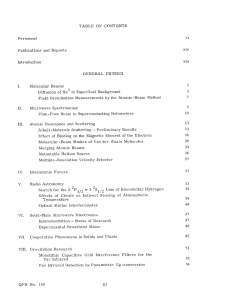PFC/JA-93-5 ANOMALOUS ELECTRON STREAMING DUE TO 1993
advertisement

PFC/JA-93-5 ANOMALOUS ELECTRON STREAMING DUE TO WAVES IN TOKAMAK PLASMAS S. D. Schultz, A. Bers, and A. K. Ram April 1993 Plasma Fusion Center Massachusetts Institute of Technology Cambridge, Massachusetts 02139 USA This work was supported by DOE Grant No. DE-FG02-91ER-54109, NSF Grant No. ECS-88-22475, and the Magnetic Fusion Science Fellowship Program. Reproduction, translation, publication, use and disposal, in whole or part, by or for the United States Government is permitted. To be published in: Proceedings of the Tenth Topical Conference on Radio Frequency Power in Plasmas, Boston, Mass., 1-3 April 1993, ed. M. Porkolab, Amer. Inst. of Phys., New York. 1 ANOMALOUS ELECTRON STREAMING DUE TO WAVES IN TOKAMAK PLASMAS S. D. Schultz, A. Bers, and A. K. Ram Abstract . . . . . . . . . Introduction . . . . . . . . . . . . . . . . . .1 . . . . . . . . . .1 Hamiltonian Guiding Center Theory . . . . . . . . . .1 Numerical Integration . . . . . . 2 Interpretation of Results . . . . . . . . . . . . . . 3 Acknowledgements . . . . . . . . . . . . . . . . 3 References . . . . . . . . . . . . . . . . . . . 3 Figures . . . . . . 4 . . . . . ii . . . . . . . . . . . . . . . . . ANOMALOUS ELECTRON STREAMING DUE TO WAVES IN TOKAMAK PLASMAS S.D. Schultz, A. Bers, and A.K. Ram Plasma Fusion Center, MIT, Cambridge, MA 02139 1. Abstract The motion of circulating electrons in a tokamak interacting with electrostatic (lower hybrid) waves is given by a guiding center Hamiltonian and studied by numerical integration. On surfaces with rational safety factor q, superposition of modes with degenerate values of the parallel mode number n + (m/q) is shown to result in electron streaming perpendicular to the magnetic field. 2. Introduction Recent work by Kupfer [1,2] on the chaotic electron dynamics induced by waves demonstrated that in the presence of four waves wherein two are of identical parallel phase velocity, an electron in resonance with the waves will have a drift in the radial direction. The work we present expands upon these results, with the intent of formulating a theory explaining the existence and properties of this "streaming". The problem is complicated by the necessity of visualizing dynamics in a four-dimensional phase space including both parallel and radial motion. 3. Hamiltonian Guiding Center Theory We use a Hamiltonian description of the electron guiding center motion that was derived in detail in [2), which makes use of several previous guiding center theories [3,4,5]. The model is based on a tokamak with an MHD equilibrium in the low-beta limit, and a low inverse-aspect ratio e = r/R. The electron is circulating, with an orbit which remains near its initial flux surface. Although magnetic field shear can be included in the derivation, it is neglected for purposes of this work. The phase space for the guiding center motion is reduced to four dimensions by gyroaveraging and assuming the magnetic moment it to be a constant: this requires that our study be restricted to waves in the low-frequency, long-wavelength limit. The derivation gives two sets of canonical coordinates for the guiding center, (z 1 ,p 1 ) and (z2,P 2 ). In terms of the familiar guiding center position (.0,6, ) and parallel velocity v11, and omitting correction terms of order E, one finds Z1 Z2 Pi ~t mRovj1 P2 - T 06 eV,#(1 Here q is the safety factor. The Hamiltonian in the absence of wave perturbations is H0= 2 (2) 2 + pB0 . R2R 1 This is simply the form of a free particle Hamiltonian in one dimension; drifts are accounted for in the order-E corrections of (z 1 ,pi, z 2 ,P2), which are too complicated to give in the limited space here. To this Hamiltonian we add a small electrostatic field perturbation, -e4, in the form of a few discrete plane waves with identical frequency. f) = E mcos (no + m + k00 - wt) n,m (3) n and m are mode numbers, and kk is found using the dispersion relation of lower-hybrid waves. Using the approximate relations given in (1), we obtain P = Y n,m nm cos (ki zi + k 2 z 2 + kvp2 - Wt) (4) with ki = n + (m/q.) and k 2 = -(m/q). The dynamics of interest occur when the safety factor q, is a rational number, which makes the perturbation periodic in z, and z 2 , and allows us to choose different integers n,m giving the same value of the parallel mode number ki but different values of k 2 and kv. The electron is in resonance with a wave when d(kizi + k 2 z 2 + kVp 2 - wt)/dt = 0. The unperturbed Hamiltonian gives i 1 = (mR2)- 1 pi and the other three coordinates constant, so resonance occurs for pi = (mR,)(w/ki). 4. Numerical Integration The equations of motion derived from the perturbed Hamiltonian were used to evolve the coordinates zi(t),p 1 (t), z2(t),p2(t) in time. We select units so that me, e, R0 , and w are all unity. The safety factor is chosen to be q, = 2. To reproduce the radial streaming observed by Kupfer [2], we choose four electrostatic modes with mode numbers (n,m) = (1,1)(1,2)(2,0)(2,2); in the new coordinates (ki,k 2 ) = (3/2,-1/2)(2,-1)(2,0)(3,-1). This case is degenerate: two modes have the same parallel mode number k, = 2 with different values of k 2 and kg,. The resonance condition in simplified units is pi = 1/k,, so that the resonance surfaces in phase space are at pi = 2/3,1/2, and 1/3. The amplitude of each wave is the same and was chosen so that the separatrix layers for these three waves barely overlap, which creates a stochastic layer around all three of the resonance surfaces in (zi,pi) phase space. The initial condition of the coordinates is chosen to lie in this resonance region. The figures describe the motion observed for two cases with different initial conditions in (z 2 ,p 2 ). The two points are started on the same flux surface (P2o = 0) but at different poloidal angles (z 2 , = 0,7r) separated by AO = 7r/2. Figures 1(a) and 1(b) show the time series pi(t) (which corresponds to parallel velocity) for these two cases. In the z 2, = 0 case, pi is observed to fluctuate rapidly throughout the resonance region, spending a roughly equal amount of time near each of the three resonances. However, in the z 2 , = 7r case, the electron quickly moves into an orbit close to the pi = 1/2 resonance, which is degenerate, and stays there. Figures 2(a) and 2(b) show the time series p2(t) (corresponding to the flux coordinate) in the two cases. In the first case, motion in the p2 direction is 2 wildly fluctuating, but with occasional periods of directed, non-chaotic motion. Over long times, these periods of streaming add up to a slow drift in the radial direction. In the second case, this streaming motion is nearly continuous, and the rapid fluctuations are no longer visible on this scale, which is an order of magnitude larger than on the previous figure. 5. Interpretation of Results The electron streaming appears to be related to the patterns of constructive and destructive interference of the two degenerate waves. Let us explicitly add two such waves: o cos (k 1 z1 + = 2$ k 2 aZ 2 + kpaP2 - t) + cos (Ak 2z 2 + Akp Io cos (klz1 + 2 ) cos k 2 bz 2 + kpbP2 - t) (kizi + k 2 z 2 + kbP2 -t), where k2 = (k 2a + k2b)/2, Ak 2 = (k2a - k2b)/2, A, = (kopa + (kga - keb)/2. kvb)/ 2 , and (5) Ak, = We would like to see how this interference pattern affects the phase space of the guiding center motion. Unfortunately, a surface of section in this phase space is given by a four-dimensional mapping, which is impossible to visualize. But if a canonical transformation can be found so that two of the four phase space variables are nearly constants of the motion, a plot of this mapping in the phase plane of the other two coordinates is an approximate surface of section. From these numerical integration experiments, it was discovered that a plot of pi versus (kiz1+ k 2 z2 + kVP2) taken as a surface of section contains what appear to be KAM surfaces and islands on the three resonance lines. Figures 3(a) and 3(b) show these surfaces for the two cases described above. We observe that, in the z 2o = 7r case, a set of invariant tori appear near the degenerate resonance on this "surface of section". It is easy to show with (5) that z2o = 7,P2, = 0 is a point where the degenerate waves interfere destructively. Thus the extra KAM surfaces appear because the electron perceives no waves to interact with at this resonance. The details of the canonical transformation giving this approximate surface of section are under investigation. This is expected to reveal that there are quantities which are very nearly conserved by the streaming motion. Work supported by DoE Grant No. DE-FG02-91ER-54109, NSF Grant No. ECS-88-22475, and in part by the Magnetic Fusion Science Fellowship Program. References: [1] K. Kupfer, A. Bers, and A.K. Ram, in Research Trends in Physics: Nonlinear and Relativistic Effects in Plasmas, V. Stefan (ed.), (New York: Amer. Inst. of Phys.) 1992, pp. 670-715. [2] K. Kupfer, Ph. D. thesis, Massachusetts Institute of Technology, May 1991. [3] R.G. Littlejohn, J. Plasma Phys. 29, 111 (1983). [4] J.R. Cary and R.G. Littlejohn, Annals of Physics 151, No. 1, 1 (1983). [5] J.D. Meiss and R.D. Hazeltine, Phys. Fluids B 2, 2563, (1990). 3 0.8 ,r(b) ;; Att F 1 p, (b) 0.8 0.2 0 10E4 t Figure 1: p1 vs. t (in 071). 4 (a z2 o = 0; (b) 2 =rr 0.7 ~ 0 4 I(a) -0.4 40 10E4 t 20 (b) 0 0 10E4 t Figure 2: p1 vs. t (in w- 1 ). 5 (a) z2 o = 0; (b) z2 o =i 0.8 0 8 Pt Z-BAR 0.8 ti,~~C' O-..z % ~~'0 r .. *..*... 0 2 0 8 PI Z-BAR Figure 3. (a) z20 = Plot of P1 0, (b) z2 kiz 2 + k2 z2 + k p2- VS. = I( 6




